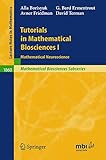Tutorials in Mathematical Biosciences I [electronic resource] : Mathematical Neuroscience / by Alla Borisyuk, Avner Friedman, Bard Ermentrout, David Terman.
Material type: TextSeries: Lecture Notes in Mathematics, Mathematical Biosciences ; 1860Publisher: Berlin, Heidelberg : Springer Berlin Heidelberg, 2005Description: X, 170 p. online resourceContent type: text Media type: computer Carrier type: online resourceISBN: 9783540315445Subject(s): Mathematics | Biology -- Data processing | Neurobiology | Differential Equations | Differential equations, partial | Biology -- Mathematics | Computer science -- Mathematics | Mathematics | Mathematical Biology in General | Ordinary Differential Equations | Partial Differential Equations | Computational Mathematics and Numerical Analysis | Neurobiology | Computer Appl. in Life SciencesAdditional physical formats: Printed edition:: No titleDDC classification: 570.151 LOC classification: QH323.5Online resources: Click here to access online
TextSeries: Lecture Notes in Mathematics, Mathematical Biosciences ; 1860Publisher: Berlin, Heidelberg : Springer Berlin Heidelberg, 2005Description: X, 170 p. online resourceContent type: text Media type: computer Carrier type: online resourceISBN: 9783540315445Subject(s): Mathematics | Biology -- Data processing | Neurobiology | Differential Equations | Differential equations, partial | Biology -- Mathematics | Computer science -- Mathematics | Mathematics | Mathematical Biology in General | Ordinary Differential Equations | Partial Differential Equations | Computational Mathematics and Numerical Analysis | Neurobiology | Computer Appl. in Life SciencesAdditional physical formats: Printed edition:: No titleDDC classification: 570.151 LOC classification: QH323.5Online resources: Click here to access online  E-BOOKS
E-BOOKS
| Current library | Home library | Call number | Materials specified | URL | Status | Date due | Barcode |
|---|---|---|---|---|---|---|---|
| IMSc Library | IMSc Library | Link to resource | Available | EBK24 |
Preface -- A. Friedman: Introduction to Neurons -- D. Terman: An Introduction to Dynamical Systems and Neuronal Dynamics -- B. Ermentrout: Neural Oscillators -- A. Borisyuk: Physiology and Mathematical Modeling of the Auditory System.
This volume introduces some basic theories on computational neuroscience. Chapter 1 is a brief introduction to neurons, tailored to the subsequent chapters. Chapter 2 is a self-contained introduction to dynamical systems and bifurcation theory, oriented towards neuronal dynamics. The theory is illustrated with a model of Parkinson's disease. Chapter 3 reviews the theory of coupled neural oscillators observed throughout the nervous systems at all levels; it describes how oscillations arise, what pattern they take, and how they depend on excitory or inhibitory synaptic connections. Chapter 4 specializes to one particular neuronal system, namely, the auditory system. It includes a self-contained introduction, from the anatomy and physiology of the inner ear to the neuronal network that connects the hair cells to the cortex, and describes various models of subsystems.


There are no comments on this title.